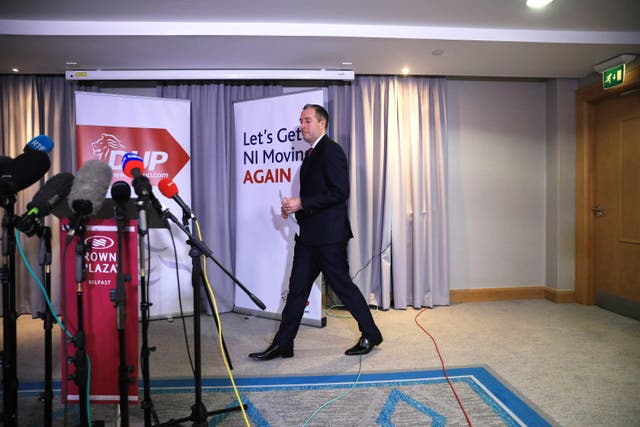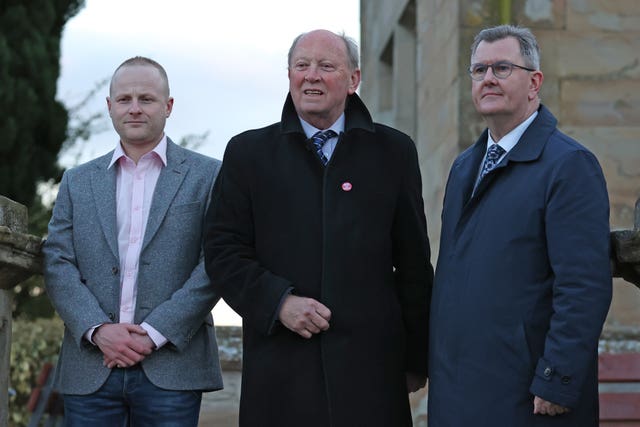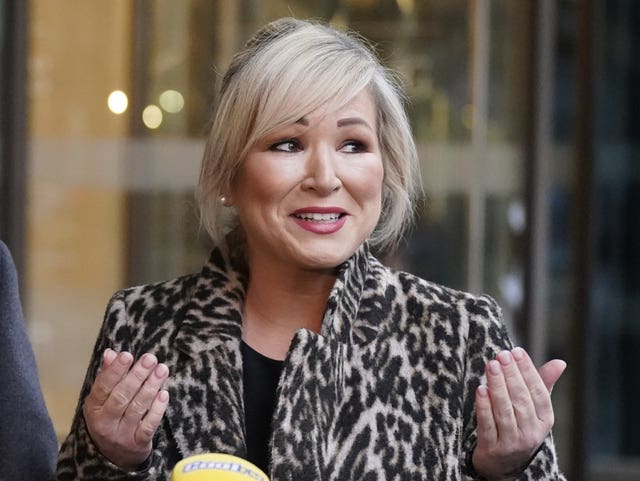Here are answers to some of the key questions surrounding the Government package that is set to deliver the restoration of powersharing in Northern Ireland.
– What led to the current Stormont stalemate?
During the Brexit divorce talks, former prime minister Boris Johnson negotiated the Northern Ireland Protocol with the EU in order to ensure the continued free movement of goods on the island of Ireland.
However, this led to the requirement for checks on goods travelling between Great Britain and Northern Ireland and was deeply unpopular with unionists, who described it as an Irish Sea border.
After feeling that the Government was not responding fast enough to his concerns, DUP leader Sir Jeffrey Donaldson collapsed the Stormont powersharing institutions when he withdrew Paul Givan as first minister almost two years ago.
In response, Prime Minister Rishi Sunak negotiated the Windsor Framework with the EU, introducing new rules on the movement of goods and a veto for the implementation of EU law in Northern Ireland.
However, Sir Jeffrey insisted this did not go far enough, leading to months of protracted negotiations that have culminated in the command paper Safeguarding The Union, published by the Government.

– Why has the DUP agreed to the deal?
Sir Jeffrey has insisted the new arrangements have removed the Irish Sea trading border and restored Northern Ireland’s place within the UK internal market.
The deal will see the end of routine post-Brexit checks on goods shipped from Great Britain to final destinations in Northern Ireland, as well as a series of measures aimed at providing assurances around Northern Ireland’s constitutional position within the United Kingdom.
The DUP leader says this is the best deal that could be achieved for the people of Northern Ireland and has persuaded him to end his boycott of the powersharing institutions.
Sir Jeffrey has long argued in favour of restoring devolved government, providing his concerns over post-Brexit trade and sovereignty were addressed.
– Does this represent a major change to the trading arrangements agreed with Brussels?
It depends who you listen to.
Sir Jeffrey says his party has delivered “fundamental change” to the Windsor Framework by ending routine checks on goods moving from Great Britain to and staying in Northern Ireland.
Downing Street, however, has insisted the measures unveiled on Wednesday do not require specific EU sign-off, characterising them instead as “operational” changes to the framework, without altering the “fundamentals” of the bilateral deal.
The EU, for its part, has said it will “carefully analyse” the measures.
Foreign Secretary Lord Cameron and Northern Ireland Secretary Chris Heaton-Harris both briefed EU executive vice-president Maros Sefcovic on the paper on Wednesday.
Irish deputy premier Micheal Martin has suggested Brussels will have a role, telling reporters in Belfast that the EU/UK Joint Committee will need to look at the package.
Mr Martin made clear he did not anticipate any push-back from the European Commission on what has been agreed between the DUP and UK.

– Who is opposed to the DUP leader’s move?
Not everyone in the DUP supports accepting the arrangements that will lead to a return to powersharing.
A meeting of the party’s ruling executive, where Sir Jeffrey presented the proposals to members, lasted for more than five hours on Monday night.
He was ultimately able to secure the backing of the executive, insisting the margin of support was “decisive”, and the endorsement of the majority of his 12 party officers.
However, just hours after the command paper was published on Wednesday, senior DUP MP Sammy Wilson launched a scathing broadside against the Government in the House of Commons in a clear sign of the differing opinions at the highest levels of the party.
The arch Brexiteer claimed the ongoing application of EU law in Northern Ireland was the result of a “spineless, weak-kneed, Brexit-betraying Government, refusing to take on the EU and its interference in Northern Ireland”.
On top of internal tensions, Sir Jeffrey faces criticism from some in the wider unionist and loyalist community.
They insist the Stormont boycott should only end when the contentious Northern Ireland Protocol, and the subsequent Windsor Framework, are scrapped entirely.
Traditional Unionist Voice (TUV) leader Jim Allister is a vocal critic, describing the DUP as “protocol implementers”.
High-profile loyalist activist Jamie Bryson, who live-tweeted elements of the private DUP executive meeting after securing an audio feed from a wired-up mole inside the party, has challenged Sir Jeffrey to a public debate on the new measures.
There have also been suggestions on social media that roads could be blocked in loyalist areas as part of protests against the deal.
The DUP leader has hit back, claiming his opponents have delivered a “big blank sheet of nothing” when it comes to removing the Irish Sea border.

– So what happens next?
The Government aims to fast-track two statutory instruments through Westminster on Thursday.
One will provide legislative assurances on Northern Ireland’s constitutional position within the UK with the other delivering the changes to the trading system by amending the Internal Markets Act.
Their passage would pave the way for the DUP to give the green light for a Stormont return.
MLAs have already been put on notice on the prospect of a hastily-recalled sitting.
The expectation is Stormont could be back up and running as soon as Saturday, when the Assembly chamber at Parliament Buildings would witness the historically significant moment of the appointment of its first-ever nationalist first minister, Sinn Fein’s Michelle O’Neill.
